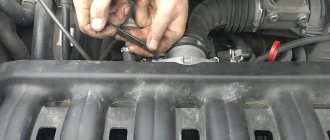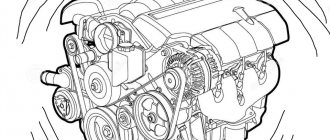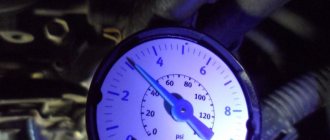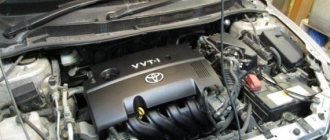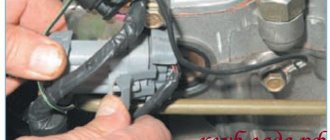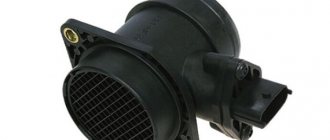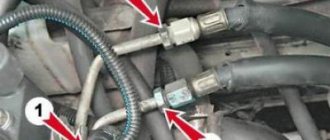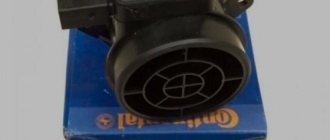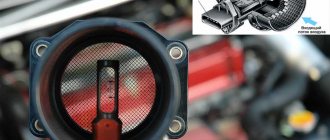Air leaks in the intake manifold are a common problem that manifests itself in unstable engine operation. Intake leakage leads to serious malfunctions; signs of air leakage in the intake manifold:
- the engine runs unevenly;
- the power unit shakes;
- RPM fluctuates.
However, it can be difficult to detect the area where air is being sucked in. For this reason, it is important to know how to check for air leaks in the intake manifold, as well as in the engine as a whole. Read more in our article.
Looking for air leaks
Since injection and carburetor engines are structurally different, especially their fuel and air systems, we will consider possible places for air leaks separately.
Injection cars:
- Vacuum booster and its hoses;
- Idle air control (if equipped) in the sensor area;
- Intake manifold gasket;
- Canister purge valve;
- Throttle assembly gasket;
- Injectors (via O-rings);
- The pipe between the throttle body and the air filter.
- Pipes of the crankcase ventilation system.
- Receiver studs.
Read - what happens if you turn off the adsorber.
Carburetor:
Points 1 and 3 above are also typical for carburetor engines. Next, you should pay more attention to the carburetor, since it is there that air is most often sucked in, namely:
- Through the gasket located under the carburetor;
- Through failed diaphragms of the economizer damper, starting throttle.
- Incomplete fit of the throttle valve (for example, as a result of its clogging);
- Through the fuel mixture quality screw;
- Air leaks through the throttle axles.
- Through the gasket between the float chamber cover and the body. As a result of strong compression, the housing surface bends; it can reach 1-2 mm in the center. A gasket won't help the situation. Needs sanding.
Fault detection methods
As a rule, the possibility of air penetration through a loose connection is the last thing people remember, when other problems are excluded - failure of sensors, regulators, and so on. Meanwhile, there is a simple way to find air leaks - with the engine running, slowly close the throttle valve with your palm. If the engine does not stall, then a gap has appeared in the area after the mass air flow sensor, into which additional flow leaks.
Note. Hearing a whistle or hissing at the leak site is not an easy task, since the noise of the running motor interferes. Therefore, this diagnostic method is not suitable.
To localize the problem area, it is recommended to check the tightness of the brake vacuum booster as follows:
- Start the engine and wait until the idle speed stabilizes.
- Push the rubber pipe leading from the power unit to the amplifier housing at several points.
- If the engine operation does not change, then there is no suction in this area. A malfunction will be indicated by an increase in crankshaft speed.
Symptoms
It is important to understand that a severely lean fuel mixture will cause a corresponding error on the instrument panel (injector) - this will indicate a large air leak, which will prevent stable operation of the engine.
A slight depletion of the mixture will be one of the reasons for floating idle speeds, which the ECU can somehow correct.
Symptoms of air leaks are not difficult to distinguish from any others, these are:
- Difficulty starting the engine;
- Increased fuel consumption;
- Floating idle speed leading to engine stoppage;
- Reduced power, engine does not pull.
It's worth explaining a little here.
As for point 2 - when air is leaking, you have to spend more time driving in a lower gear, while the gas pedal needs to be squeezed almost to the floor, keeping the speed increased.
According to point 3, the idle speed does not hold well, and at 900-1000 rpm the car may stall. Many owners of carburetor cars immediately try to correct the situation with the help of a screw for the quality and quantity of the fuel mixture, but as a rule, this does not help, since excess air does not flow through the idle channel, but, for example, through the gasket under the carburetor.
According to point 4, other reasons besides air leaks can lead to a drop in power; it all depends on what systems are structurally implemented in the engine.
Reduced idle speed is typical for MAF systems where a mass flow sensor (mass fuel flow sensor) is installed in the intake tract - errors in its operation are possible.
In systems with an absolute pressure sensor (with a MAP sensor), a drop in power can be caused by errors in the lambda probe, misfires, and again a lean mixture.
Many car owners make the mistake of immediately changing the IAC or mass flow sensor when the idle is floating. There is no need to do this. First, diagnose the engine for possible air leaks using the methods listed below.
Detecting air leaks in the intake manifold
The essence of the problem is that in engines with the above systems, excess air penetrates into the combustion chamber.
It is sucked in after the MAF/DBP (absolute pressure sensor). As a result of this, the ECU receives data that diverges from the real ones and this causes the engine to operate incorrectly.
One of the problem areas is the gasket between the intake manifold and the cylinder head. Here, air leaks can be minimal, it is difficult to visually identify minor damage and therefore not everyone pays attention to this place.
But seals in the form of gaskets and sealant can leak in other places, the reason for this may be:
- Decrease in their elasticity due to overheating or long service life;
- Frequent use of cleaning agents for throttle assemblies and carburetors. These products gradually soften the seals, which promotes air leaks.
- Mechanical impact on gaskets if they are replaced incorrectly.
Air leak in the manifold
Standard places for air leaks in the manifold are:
- Microcracks in air ducts;
- Loose connections;
- Through the hoses of the vacuum brake booster;
- Through the fuel injector seals.
It is through these places that excess air, which is not taken into account by the mass air flow sensor, enters the combustion chamber.
Looking for air leaks
There are many methods for finding air leaks; we’ll tell you about the most effective ones:
- Forced shutdown of air supply to the engine.
- Use of a smoke generator;
- Compressed air;
- Clamping of hoses;
- Wetting possible leak points with gasoline, carburetor cleaner, VD 40 or other flammable liquids.
Air shut off
The essence of the first method is to disconnect the pipe from the air filter and block it. With this we will check whether air is passing through the seals in front of or behind the flow meter.
Algorithm of actions:
- Unscrew the air duct in the area of the air filter;
- We start the car;
- We close the hole in any possible way.
If after the flow meter (mass air flow sensor) the pipe is strongly compressed (residual air is sucked in) and the engine stalls, this is normal. And if the engine continues to work, albeit intermittently, then by the hissing that will most likely occur, you can determine where the air is being sucked in.
The disadvantage of this method is that when the engine is running and the corrugation is blocked, oil can be drawn into the throttle assembly through the oil baffles. This is especially dangerous on engines with high mileage or after major repairs.
Checking suction with a smoke generator
Many will notice that checking air leaks with a smoke generator is done at a service station and not everyone has such a device in the garage. But who is stopping you from making a smoke generator yourself with your own hands, because in reality, there is nothing complicated here.
Prepare:
- 12V car compressor or regular pump.
- A food container with a volume of at least a liter. Please note that the container must have a tight lid, preferably silicone.
- Two tubeless nipples. In one there should be a spool through which pressure from the compressor will be supplied, in the second - unscrew the spool, since through it smoky air will be supplied to the system.
- 2-3 cigarettes.
Make holes on both sides of the container at the same level and insert tubeless nipples into them. Sealant can be used to seal.
Connect the hose to the nipple without spool. The hose can be taken from the return valve of the absorber purge valve.
Further procedure:
- Disconnect the pipe with the flow meter from the air filter and close it in any way possible.
- Disconnect the crankcase ventilation hose and plug it. Instead, connect the hose coming from the container.
- We insert the smoked cigarette into the nipple without a spool with a filter and close the lid tightly.
- Connect the compressor to the first nipple and turn it on.
The forced air will create pressure, and the smoke from the cigarette will begin to spread throughout the system and, where there is suction, it will begin to come out.
Another variation of the smoke generator.
Clamping the hoses
In this case, you need to be careful, since air leaks are detected with the car running.
The essence of the method is that at the first stage, places of air hissing are detected by ear, and at the second stage, when pinching and releasing the hoses of the vacuum booster, fuel pressure regulator and others going to the intake manifold, engine operation is monitored.
If any changes are observed in its operation during the above-described manipulations, then a specific area will be checked in depth.
Spray method
This method must be used with caution so as not to burn the car because you will have to use flammable liquids (gasoline, carburetor cleaners, etc.). Do not overheat the engine or use open fire.
The essence of the method is as follows: through the supposed places of air leakage, flammable vapors, for example, from gasoline, should enter the system. As a result, the mixture will become richer and the engine operating mode will change.
To accomplish your plan, fill the syringe with a flammable mixture and start the car. Using a syringe, carefully spray the liquid in places where the likelihood of air leaks is maximum, and this is:
- All pipes and their connections from the air filter to the valve cover;
- Gaskets for injectors and between the cylinder head and the intake manifold;
- At the junction of the throttle pipe and the receiver.
An increase in engine speed will indicate that a flammable liquid is entering the system through this place, which means it is sucking in air here.
Second spraying method
In this case, not a flammable mixture is used, but a soap solution with a spray. You can use any detergent diluted with water.
To implement the method you will need:
- 12V car compressor (foot or hand pump) with an adapter for inflating mattresses (usually included).
- Spray bottle with detergent.
- Cellophane bag.
- A rubber pipe of suitable diameter, 1.5 meters long.
Procedure:
- We remove the pipe from the flow meter (mass air flow sensor), cover the hole with a bag and put everything back, tightening the clamps well.
- We assemble the circuit - compressor, adapter, pipe.
- Instead of the air recirculation valve, we connect our pipe. Some cars may have a plug. You can also use the brake booster connection for connection.
Turn on the compressor. It will be noticeable how the air supply corrugation has swollen.
Then listen carefully to where the hissing is coming from. We wet all possible suction points with a soap solution. Pay attention to the connection fittings for vacuum brake booster pipes, ventilation ducts, and injector rubber seals.
In places where air is leaking, bubbles of the soap solution will be observed.
Simple smoke generator
In general, I was standing at a checkpoint the other day. And in order not to waste time, I decided to bring to life an idea that had been exciting me for a long time - to assemble a simple smoke generator to check the intake manifold.
The only suitable tools I had were a small knife and a triangular file without a handle.
A one and a half liter plastic bottle was also emptied of water. A half liter bottle of a certain drink was also purchased, which was quickly drained by my daughter
First of all, I cut the large and small bottles into two parts. I threw away the top part of the small bottle. In total, there are two lower parts left (small and large) and one upper part. I think it's clear.
I removed the hose from the crankcase ventilation valve fitting. I made a hole in the bottle cap with a file so that the removed hose would fit into it with force. Screwed the top of a large bottle onto the cap. This is the picture we got
From a different angle
Everything turned out tight
Then I dug a hole in the bottoms of both lower parts. The smaller one is the same size as a cigarette, and the upper one is the same size as the hoses from the compressor for inflating the wheels.
He shot a cigarette from the driver of the next car, lit it and inserted it into the hole of a smaller bottle, and shoved the whole thing upside down into the larger bottle.
I put it all into the top of the bottle and connected the car compressor
Here is a general view of this constructor
For a long time, the drivers of neighboring cars could not understand what I was doing so diligently, although many probably did not understand
As the experiment showed, this solution has the right to life because of its simplicity and speed of assembly. I spent half an hour at most. And then, while they were buying and drinking a drink, while they were chiseling holes in the knee with a file and shooting out cigarettes
It just needs to be modernized a little. You can insert not one cigarette, but several, so that there is more smoke. It’s even better to remember your childhood and use paper soaked in silica instead of cigarettes. I don’t know about you, but in childhood we often used smoke blowers made from such paper. There was smoke...
Also, the cap on the bottle must be screwed on through cheesecloth so that the ashes do not fly into the collector.
I will further improve it. True, this copy had to be thrown away, since during the check at the checkpoint they could have been mistaken for a drug addict.
I advise you to see what interesting solution our community member Pavel used to make a smoke generator from scrap materials
Features of testing on carburetor engines
As we said above, the first thing you need to pay attention to on such engines if you suspect an air leak is the carburetor.
Check that all fuel flows through idle. To do this, start the car and disconnect the power wire from the solenoid valve.
If the engine stalls, the situation is simplified, since the valve is working. Remove it and unscrew the idle jet. Check the diameter of the jet hole; it should be 0.40 - 0.45 mm (see the characteristics of your carburetor). If the diameter of the jet is larger than according to the specifications, replace it.
Start the engine and try to set it to XX by unscrewing the EMC. If this cannot be done and it is felt that the engine does not have enough fuel, then it means that air is being sucked somewhere.
Pay attention to possible bending of the carburetor flange. To check whether air is sucking under it or not, pour water under it.
If the engine starts to stall, then the problem is in the bend. In this case, we do not use flammable liquid, it is so dangerous. See the video from Nail Poroshin for all the details.
Vacuum hose repair
If your vacuum hose is damaged, you don't have to buy a new one. The hose is long. You can cut off the damaged part and reattach it to the engine.
The most common damage is at the ends of the tubes. Always ensure that the clamps are tight to prevent further leaks.
After repairs, start the engine and leave it idling. Listen for any hissing sounds.
If you decide to replace the vacuum hose, use one that is similar in length and diameter. Vacuum tubes are designed for specific locations, such as the brake booster or PCV (Power Crankcase Ventilation) system.
Diesel engines
In a diesel engine, diesel fuel enters the cylinders bypassing two fuel subsystems - low and high pressure. As a rule, it is in the low pressure area that air leaks occur.
This can happen through many pipeline joints, connections of fuel system elements, including the fuel injection pump.
The problem is aggravated by another point. To reduce the cost of producing diesel cars on modern models, instead of traditional brass tubes, plastic products are used, which wear out much faster.
Aggressive environment, vibrations, temperature changes - all this negatively affects their performance. This also applies to seals. As a rule, all this begins to manifest itself after 120-150 thousand km. mileage
Often, obvious leakage of diesel fuel when the engine is not running can indicate a problem area.
But when the car is running, when fuel is pumped from the tank, a pressure is created in the system that is lower than atmospheric pressure and therefore it is problematic to immediately identify air leaks.
Signs
The bottom line is that the mixture of diesel fuel and air entering the fuel injection pump when starting the engine does not allow it to perform its functions 100%, i.e. overloads it with a large amount of air in the fuel chamber.
When the car is already running, fuel enriched with air foams heavily and increases in volume. Therefore, at high speeds, the fuel injection pump does not have time to pass it through itself.
As a result, when you try to start a diesel car in the morning, you have to oil the starter for a long time, and you will see a little smoke from the exhaust pipe. And when driving or standing at traffic lights, the engine may stall due to insufficient diesel fuel entering the cylinders.
Causes
Causes of air leaks in diesel cars:
- Wear of rubber seals including fuel filters;
- Loosening clamps;
- Damage to the fuel tank;
- Wear and cracking of hoses;
- Damage in the return line;
- Wear of seals in the fuel injection pump cover, drive shaft, fuel supply lever axis.
conclusions
The optimal methods for diagnosing air leaks in the intake manifold on your own remain the use of smoke and spraying the manifold, corrugations, and throttle bodies with a thin stream of flammable liquid. Good luck with your diagnostics and smooth roads!
It is necessary to repair the exhaust manifold if leaks are detected in it - cracks, fistulas, gasket breakdowns.
If there is any leakage of the exhaust system at the beginning of the tract: gasket, manifold, corrugation, flange, air is automatically sucked into the exhaust pipe due to the fact that the engine operates in cycles. A regulating lambda probe and an oxygen sensor are installed in the exhaust manifold of the muffler of all modern cars.
It reacts to the content of free oxygen in the exhaust gases / According to its readings, the control unit either enriches or depletes the mixture.
If there is a lot of oxygen, the mixture becomes richer.
When air enters from outside, the control unit always considers the mixture lean and gives the command to enrich it.
In this case, the fuel-air mixture becomes so rich that it does not have time to burn and floods the spark plugs. Fuel consumption increases, and it can be difficult to start driving at a traffic light or in a traffic jam.
Some of the unburned gasoline ends up in the muffler and catalyst.
In this case, the catalyst may melt and fail.
The exhaust manifold usually begins to crack even more due to overheating.
The lambda probe fails due to unburned gasoline and overheating.
Such a seemingly small malfunction as an exhaust gas leak can lead to big troubles.
This happens very often when a muffler is repaired poorly, the welding quality is poor, or the personnel who repaired your exhaust manifold or muffler exhaust pipe are incompetent.
Source
